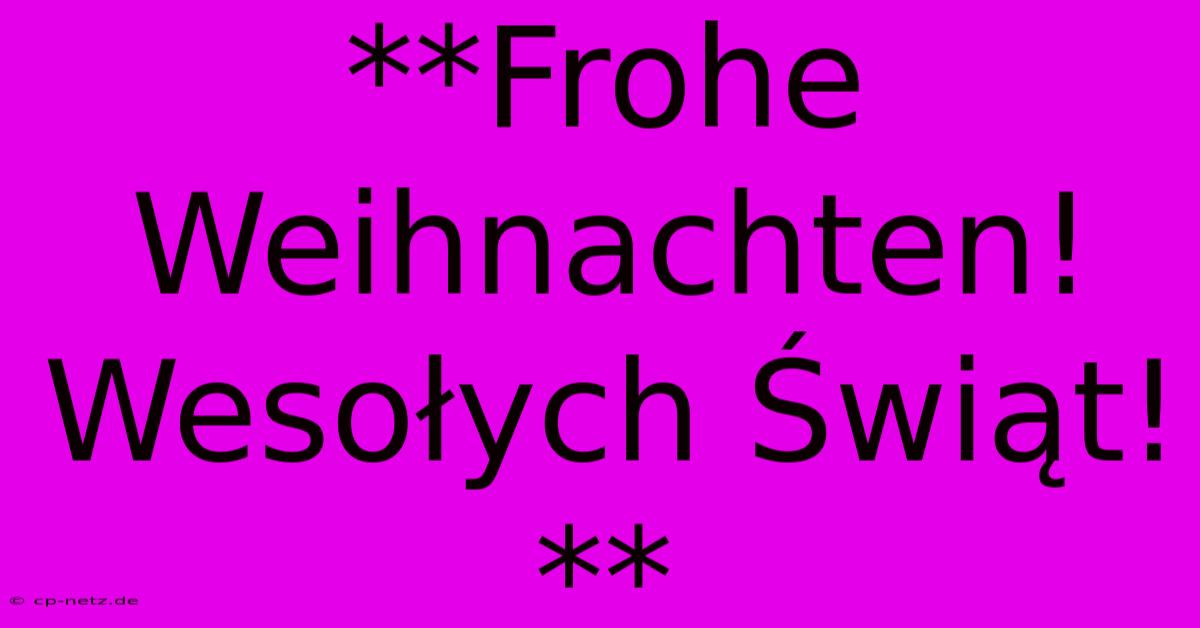**Frohe Weihnachten! Wesołych Świąt!**

Discover more detailed and exciting information on our website. Click the link below to start your adventure: Visit Best Website **Frohe Weihnachten! Wesołych Świąt!**. Don't miss out!
Table of Contents
Frohe Weihnachten! Wesołych Świąt! A Season of Mixed-Up Traditions and Delicious Mistakes!
Hey everyone! So, Christmas – or Weihnachten and Święta Bożego Narodzenia, depending on where your family tree's branches reach – is almost here. And let me tell you, it's a whirlwind of traditions, some slightly clashing, most utterly delicious. I'm talking about the kind of Christmas where you're juggling German stollen with Polish pierogi, and hoping you haven't accidentally put the opłatek wafer in the eggnog. (Don't ask me how I know that last one...).
A Tale of Two Christmases (and a Few Too Many Pierogi)
Growing up, Christmas was a beautiful blend of cultures. My mom's side, staunchly German, brought the Weihnachtsmarkt spirit – that magical feeling of mulled wine, gingerbread, and twinkling lights. My dad's Polish family? Well, they brought the serious pierogi game. Like, buckets of pierogi. Different fillings, every imaginable shape. It was amazing, but slightly overwhelming.
One year, bless my ten-year-old self, I decided to "help" with the pierogi-making. Picture this: flour everywhere, a sticky mess that rivaled a Jackson Pollock painting, and about five pierogi that looked vaguely like... well, nothing pierogi-shaped at all. Let's just say the family got a good laugh. And I learned a valuable lesson: Some traditions are best left to the experts! Pro-tip: If you're trying out a new family recipe for the holidays, start small. A test run a week before is a really good idea.
Navigating the Language Barrier (and the Gift-Wrapping Chaos)
Another hilarious challenge was navigating the language barrier. I mean, "Frohe Weihnachten!" is pretty straightforward. "Wesołych Świąt!", slightly less so. And the gift-wrapping? Forget about it! My German relatives were all about the elegant, understated wrapping, while the Polish side embraced a more... exuberant approach. Lots of ribbon, bells, glitter, you name it. It was beautiful, chaotic, and perfectly reflective of the festive energy.
Key takeaway: Don't stress about getting every detail "perfect". Embrace the differences and laugh at the small mishaps. That’s what makes a multicultural Christmas so memorable. Remember, the goal is to celebrate the holiday and spend time with loved ones, not to win a wrapping contest!
Beyond the Presents: The Heart of the Holidays
The best thing about this dual-culture Christmas experience, however, was not the food or gifts (although those were great). It was the way the two cultures celebrated the core values of the season: family, togetherness, and goodwill.
For example, while many Weihnachtsmarkt traditions emphasize a certain level of secular participation, we also maintained the religious significance of the holiday with opłatek – the thin, unleavened wafer shared with wishes for peace and prosperity. Both families honored traditions in their own way.
Think about what your family does each year. What aspects mean the most to you? What's unique and special to your experience?
This year, focus on making it a meaningful celebration, rather than a perfect one. Maybe this year you will try baking some German stollen or Polish pierogi. If you're feeling really adventurous, learn a few phrases in Polish or German – your family will love the effort!
No matter what traditions you observe, or if you're celebrating "Frohe Weihnachten!" or "Wesołych Świąt!", or both, remember the core message of the season. Spend some quality time with those you love and enjoy the magic! Merry Christmas, everyone! And remember: pierogi-making is best left to the experts. Trust me on that one. 😉

Thank you for visiting our website wich cover about **Frohe Weihnachten! Wesołych Świąt!**. We hope the information provided has been useful to you. Feel free to contact us if you have any questions or need further assistance. See you next time and dont miss to bookmark.
Featured Posts
-
Schmid Erhaelt Kronzeugenstatus Oe Vp
Nov 29, 2024
-
Aktienschock Hugo Boss Kurs Stuerzt Ab
Nov 29, 2024
-
Bitterer Auswaerts Daempfer Fuer Hoffenheim
Nov 29, 2024
-
Nfl Thanksgiving Heimrecht Dallas Detroit
Nov 29, 2024
-
Daenemark Ausfall Von Handynetz Und Zuegen
Nov 29, 2024
